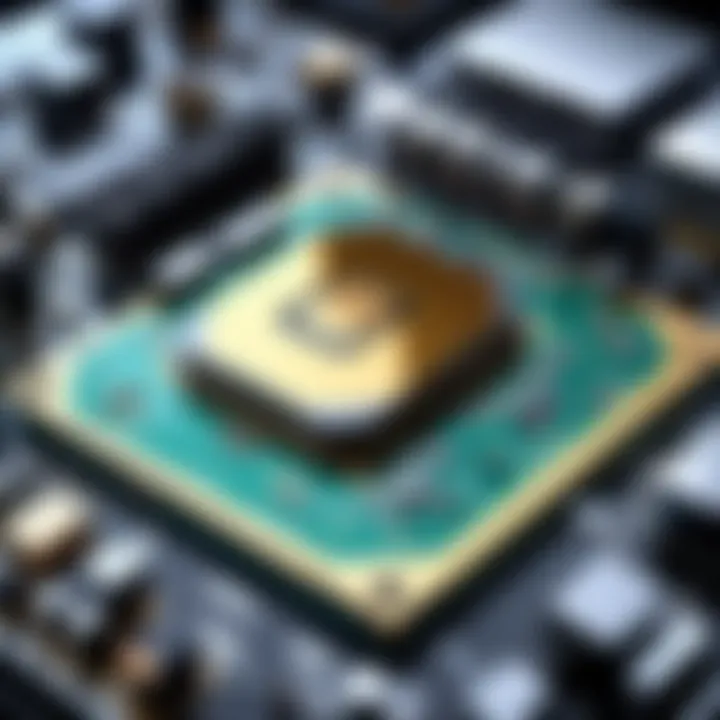Exploring Z370: Unraveling Motherboard Advancements


Intro
The Z370 chipset represents a significant development in motherboard technology, adapted for modern computing's demands. Introduced alongside Intel’s 8th generation processors, it elevates user experiences in personal computing, gaming, and professional applications.
This section unpacks its architecture and capabilities while distinguishing it from previous generations. Understanding the Z370's place in the broader context of motherboard technology can inform IT professionals and tech enthusiasts on making more educated choices about hardware upgrades and builds.
Product Overview
The Z370 motherboard lineup presents a range of features tailored for enhanced functionality and performance. Users can expect several key attributes that distinguish these motherboards as trustworthy options for Intel’s 8th generation processors.
Key Features
- Compatibility with Intel 8th Gen Processors: Ensures optimal performance through a tailored design incorporated for processors like i7-8700K and i5-8600K.
- Enhanced Overclocking Support: Provides extensive overclocking features which allow users to push their hardware to limits.
- Dual-Channel DDR4 Memory Support: Facilitates faster data transfer rates and broader bandwidth, ideal for high-speed applications.
- Multiple PCIe 3.0 Slots: This capability allows for multiple GPU configurations, enhancing gaming and graphic performance.
- Integrated USB 3.1: Offers improved connectivity options, enhancing data transfer efficiency.
Technical Specifications
The following technical specifications illustrate the Z370 chipset capabilities:
- Support for 64GB DDR4 RAM
- USB 3.1 Gen 2 and Gen 1 Ports
- Intel Optane Memory Support
- 24 PCIe lanes available for expansion cards
These specifications indicate a robust and versatile approach to system building, catering to a variety of user needs, from hardcore gaming to general productivity.
Performance Analysis
Understanding how the Z370 performs in both synthetic and real-world scenarios is essential.
Benchmark Test Results
Benchmark tests reveal that the Z370 chipset offers impressive performance improvements over its predecessors. In CPU-centric tasks, the Z370 motherboard showcases quick processing speeds. This is particularly evident in gaming benchmarks where frame rates and loading times improve considerably.
Furthermore, stress tests demonstrate its ability to handle overclocking efficiently, maintaining stability even at maximum loads.
Real-World Usage Scenarios
In actual usage, Z370 motherboards shine in various applications. For instance, during gaming sessions, the benefit of higher refresh rates creates a smoother gaming experience.
Additionally, in heavier workloads, such as video editing with tools like Adobe Premiere Pro, the enhanced RAM support plays a crucial role in performance, significantly reducing render times and enabling smoother multitasking.
"The Z370 chipset exemplifies how careful engineering can elevate performance to meet the contemporary demands of multitasking and gaming."
Overall, the Z370 lineup presents a compelling choice for professionals and enthusiasts alike. Its balance of features and performance positions it as a strong contender in the ever-evolving landscape of motherboard technology.
Overview of the Z370 Chipset
The Z370 chipset serves as a crucial component within the ecosystem of modern computer motherboards. Understanding its features and significance can greatly enhance one’s grasp of motherboard technology. This section will provide a detailed overview of the Z370 chipset, emphasizing its key attributes and architectural nuances.
Preface to Chipsets
Chipsets are vital for enabling communication between the motherboard and various components, such as the CPU, memory, and storage. They dictate compatibility and performance, directly influencing the overall capabilities of a system. The Z370 chipset, released alongside Intel’s 8th generation processors, represents a significant evolution from its predecessor, the Z270.
This change is notable not only in performance enhancements but also in support for new technologies, such as faster memory interfaces and improved overclocking features. Its design aims to facilitate seamless interaction between hardware components, which is essential in today’s data-intensive environments.
Key Features of Z370
The Z370 chipset is equipped with several key features that set it apart from previous iterations:
- Enhanced Overclocking Support: The Z370 allows for more refined overclocking options, providing users with greater control over their system’s performance. This is a pivotal aspect for enthusiasts looking to maximize their computing power.
- Dual Channel Memory Support: Supporting DDR4 memory, it can handle configurations more efficiently than its predecessors.
- Increased PCIe Lanes: The chipset provides additional PCIe 3.0 lanes, enhancing data transfer rates for graphics cards and other expansion cards.
- USB 3.1 Gen 2 Support: It includes support for faster USB connections, accommodating modern peripherals and contributing to improved overall performance.
These features collectively allow the Z370 chipset to handle more demanding applications, making it a suitable choice for gamers and professionals alike.
Z370 Architecture Explained
Understanding the architecture of the Z370 chipset reveals the details behind its operation. Structurally, the Z370 integrates core functions within a well-defined interface.
Architecture Breakdown:


- Southbridge and Northbridge Integration: The traditional Northbridge/Southbridge design is simplified in the Z370, leading to lower latency and better performance.
- Support for Intel Optane Memory: Integration of Intel Optane technology enhances storage capabilities, allowing for faster data access and improved system responsiveness.
- Power Management Features: These features optimize the distribution of power among components, improving efficiency and thermal management.
In summary, the architecture of the Z370 chipset represents an advancement in design and functionality, aligning with the needs of modern computing demands. Its architecture not only bolsters performance but also reinforces the importance of compatibility with current and future technologies.
Comparison with Previous Chipsets
In the realm of motherboard technology, the Z370 chipset stands as a noteworthy evolution over its predecessors, specifically the Z270. Understanding this comparison is crucial for anyone looking to optimize their systems. This section delves into the distinctions, advantages, and considerations that come forth when evaluating these chipsets. By examining Z370 against Z270, one can grasp the technical advancements that have shaped performance metrics and user experiences in modern computing environments.
Z270 vs. Z370
When comparing the Z270 and Z370 chipsets, it is essential to identify the direct enhancements and differences that are evident between the two.
The Z270, while robust in its capabilities, had its limitations. It supported only Intel's 7th generation processors and offered basic overclocking features. In contrast, the Z370 chipset supports Intel's 8th generation processors, significantly improving performance capabilities.
Also, Z370 includes a higher number of PCIe lanes, allowing for enhanced graphics card performance and additional connectivity options. This is particularly beneficial for users requiring multi-GPU setups or those who utilize various peripherals simultaneously.
Some critical differences include:
- Increased PCIe Lanes: Z370 provides more PCIe lanes than Z270, facilitating better expansion options.
- Enhanced Power Delivery: The power delivery systems in Z370 are optimized for better overclocking potential, which is an essential aspect for high-performance setups.
- Native USB 3.1 Support: Z370 features native USB 3.1 support, a significant upgrade over the Z270, allowing for faster data transfer rates.
On a practical level, these improvements translate into better performance in demanding tasks, including gaming and content creation.
Key Improvements in Z370 Architecture
The architectural advancements present in the Z370 chipset are noteworthy. The upgrades are not mere incremental changes; they signify a shift in how motherboards interact with CPUs and other components.
Firstly, the compatibility with the latest 8th generation Intel processors allows Z370 to take full advantage of the Coffee Lake architecture. This integration ensures that the newer processors can deliver higher core counts and clock speeds, directly enhancing overall system performance.
Moreover, the Z370 introduces a new and efficient signal routing layout, optimizing internal communications between components. This results in lower latency and improved data throughput, crucial for gamers and professionals who demand responsiveness from their machines.
The incorporation of improved thermal management solutions is also vital. The Z370 boards tend to feature better heatsinks and fan headers, which help maintain stable performance during intense workloads. This is particularly important as users engage in overclocking, where temperature control becomes paramount.
As technology continues to evolve, understanding the nuances between chipsets like the Z270 and Z370 can empower users to make more informed decisions about their hardware investments.
In summary, the Z370 chipset presents significant improvements over the Z270, impacting various aspects of performance and capability. It is this ongoing evolution that reflects the dynamic nature of motherboard technology. Users interested in maximizing their systems will find ample justification for choosing Z370 over its predecessor.
Compatibility with Intel Processors
The compatibility of the Z370 chipset with Intel processors forms a critical part of its function and utility. Motherboards serve as the backbone of computer systems, providing essential connections and compatibility with various components. This section will examine the Z370 chipset in relation to Intel processors, focusing on supported generations and specific challenges.
Supported Intel Processor Generations
The Z370 chipset specifically supports Intel's 8th generation Core processors. This group includes models such as the Core i3, Core i5, Core i7, and Core i9. This focus on newer generations allows users to harness cutting-edge performance and efficiency improvements.
Benefits of using the Z370 with 8th generation processors include enhanced performance capabilities. These processors incorporate newer technologies, such as improved cache architectures and support for dual-channel DDR4 RAM. The benefit of these advancements translates to noticeable increases in both processing speed and multitasking capabilities, essential for gaming and demanding applications.
"Using the Z370 with 8th generation processors maximizes system performance, bringing modern applications to life."
Processor Compatibility Challenges
While the Z370 chipset boasts strong compatibility with the 8th generation Intel processors, there are challenges that users may face. One notable issue is the lack of backward compatibility with Intel's 7th generation processors. This means that users upgrading from Z270 motherboards may require a new motherboard entirely if they wish to switch to an 8th generation processor.
There are also challenges related to the BIOS versions utilized. Users might have to update the BIOS to ensure proper performance and functionality with newer processors. Not all Z370 motherboards will come ready out-of-the-box for the latest CPUs, requiring additional efforts from users to upgrade the system.
Key considerations include:
- Ensuring BIOS is updated to the latest version.
- Verifying that the chosen motherboard indeed supports the selected Intel processor model.
- Knowing that not all Z370 boards are equal; some models may feature better power delivery systems than others, affecting overall performance.
Performance Metrics
Performance metrics serve as a crucial yardstick for evaluating the capabilities and overall effectiveness of any technology. For motherboards, especially the Z370 chipset, these metrics help users understand how well the system handles various tasks and workloads. It is within this analytical framework that we can explore not just theoretical performance, but also real-world implications.
When assessing performance, several specific elements become relevant. Among them, benchmarking scores and real-world application performance are especially significant. Benchmarking, while providing a theoretical upper limit to performance, indicates how the Z370 compares against established standards as well as previous generations. Real-world performance is often far more telling for end-users since it reveals how systems perform under typical operational loads. Together, these measures outline a comprehensive profile of what one can expect from a Z370-based system, as well as determining its suitability for specialized applications like gaming or data-intensive tasks.
As technology progresses, understanding these metrics also becomes increasingly complex. Therefore, it is critical for tech enthusiasts and IT professionals alike to navigate through this information carefully, ensuring they make informed decisions based on empirical data rather than mere speculation. As we delve into the specifics, it is important to keep in mind the various metrics that will be discussed in detail next.
Benchmarking Z370 Performance
To assess the performance of Z370 motherboards effectively, benchmarking tests stand as vital indicators. These tests are designed to push hardware to its limits, offering a quantifiable results that can be compared across different platforms. Various tools, such as Cinebench, 3DMark, and PCMark, are commonly utilized to achieve these benchmarks. Each of these tools serves a different purpose, measuring everything from CPU capabilities to graphics performance.


The Z370 chipset exhibits impressive scores across multiple benchmarks when paired with compatible Intel processors. This capability emphasizes its role as a robust platform for both gaming and professional workstations. Higher scores in CPU intensive applications signal a well-optimized architecture that benefits from the improved bus speeds and memory compatibility introduced with Z370.
Another important aspect is the overclocking potential of Z370 motherboards. Many models feature advanced BIOS settings that allow users to push performance beyond stock configurations, leading to increased benchmarking scores. However, it is essential to note that overclocking also demands an adequate cooling solution to maintain performance stability.
Real-World Application Performance
While benchmark scores provide useful insights, real-world applications shine a light on practical performance. It is important to scrutinize how these metrics translate into everyday usage. Users expect their systems to perform efficiently under common workloads like video editing, gaming, and software development.
For instance, in gaming, the Z370 platform shows marked improvements in framerates compared to its predecessors. This is attributed to its support for faster memory and enhanced power delivery systems, which are crucial for performance in graphic-intensive scenarios. Users have reported substantial gains in titles like Shadow of the Tomb Raider and Call of Duty: Modern Warfare, demonstrating how the Z370 effectively utilizes resources under demanding situations.
Moreover, during lengthy tasks such as video rendering or 3D modeling, the efficiency of the Z370 chipset becomes evident. Optimized memory lanes and improved PCIe bandwidth result in reduced bottlenecks, allowing better management of resource-intensive applications.
The direct impact of these performance metrics cannot be overstated. Users notice smoother operations, reduced lag, and a more responsive overall experience, which ultimately enhances productivity.
In summary, both benchmarking and real-world application performance metrics not only authenticate the capabilities of Z370 motherboards but also serve as essential tools for evaluation. Gaining an understanding of these aspects positions users to take full advantage of the chipset's potential, ensuring their investment aligns with their unique computing requirements.
Gaming with Z370 Motherboards
The Z370 chipset has become a cornerstone for gamers seeking optimal performance paired with advanced technology features. Its design integrates well with Intel's 8th generation processors, providing a robust platform for gaming. The emphasis on gaming with Z370 motherboards is not merely a trend but a necessity for those who seek sustained performance and reliability. Understanding the intricacies involved in gaming on these motherboards offers insights into their significance in modern gaming setups.
Gaming Performance Overview
Gaming performance is measured by several factors, including frame rates, lag, and overall system responsiveness. The Z370 motherboards contribute significantly to achieving high performance due to their compatibility with fast DDR4 memory and the capability to support multi-GPU configurations. This enhances the overall graphical fidelity experienced during gameplay.
In practical terms, motherboards built on the Z370 chipset can harness high bandwidth thanks to their PCIe lanes. This means that gamers can utilize faster video cards effectively without bottlenecks. Users often report smoother gaming sessions and higher frame outputs with Z370 motherboards as compared to older models like the Z270.
Moreover, attributes such as enhanced power delivery systems and sophisticated cooling solutions play crucial roles in sustaining performance during prolonged gaming periods. Gamers can expect improved thermal management in Z370 motherboards; this helps maintain stable performance without unexpected crashes or slowdowns.
Optimizations for Game Streaming
Game streaming has taken off as a prevalent activity among the gaming community, and Z370 motherboards provide specific optimizations that cater to this growing trend. With features like Intel's Quick Sync Video technology, gamers can stream games without sacrificing their gaming performance. This allows for seamless broadcasting to platforms such as Twitch and YouTube.
Additionally, many Z370 motherboards come equipped with multiple USB and audio outputs. This support facilitates easy connection of streaming peripherals, ensuring that streamers have all necessary tools at their disposal. Online presence in gaming often hinges on quality, and Z370 helps achieve that.
In the context of connectivity, LAN technologies incorporated in these motherboards ensure minimal latency during online gaming and streaming. This significantly enhances the overall experience, giving players an edge over competitors who may rely on inferior setups.
"Gaming on Z370 motherboards not only enhances performance but also streamlines the streaming experience, making it easier for gamers to share their passion with an audience."
In summary, the Z370 chipset excels in providing a gaming environment that caters to high-performance needs while also considering streaming capabilities. These motherboards are tailored to optimize both gaming and broadcasting, showing that they can do more than just run games; they can enhance the overall gaming experience.
Popular Z370 Motherboards
The popularity of certain Z370 motherboards reflects their ability to meet the demands of modern users, especially in terms of performance, features, and compatibility. Choosing the right motherboard is crucial for optimizing the performance and stability of any build. There are many factors to consider, like design, build quality, and the specifics of user requirements. Whether you are a gamer, content creator, or a general user, understanding which models are most favored can help guide your decision.
Top Models Reviewed
Several models have emerged as the forerunners in the Z370 motherboard market. These boards not only support Intel's 8th generation processors but also offer varying features that cater to different user preferences:
- ASUS ROG Strix Z370-E Gaming: This motherboard is known for its robust performance and aesthetic design, featuring customizable RGB lighting. It comes with enhanced cooling options and ample connectivity, making it ideal for competitive gaming.
- Gigabyte Z370 AORUS Gaming 7: With a dual BIOS configuration and multiple M.2 slots, this model provides excellent flexibility. It also has a superior power delivery system, which is beneficial for overclockers.
- MSI Z370 GAMING PRO CARBON: This board strikes a balance between performance and affordability. It includes premium features like a reinforced PCI-Express slot, which is vital for preventing GPU sag.
These models exemplify the variety present in the Z370 lineup, each offering something unique in terms of features, performance, and aesthetics. Choosing the right model depends on individual needs and use cases.
Features Comparison
When examining different Z370 motherboards, it is essential to consider their features.
- Power Delivery and Overclocking Capabilities: High-end motherboards like the ASUS ROG Strix often have superior power delivery systems and advanced BIOS options. This allows users to overclock their CPUs efficiently.
- Cooling Solutions: Good motherboards will integrate cooling features such as heat sinks or fan connectors. For example, the Gigabyte AORUS includes smart fan technology offering customizable cooling options.
- Connectivity Options: Z370 boards vary in USB ports, Ethernet capabilities, and support for NVMe SSDs. The MSI Z370 GAMING PRO CARBON is notable for its extensive range of ports and slots for future upgrades.
- Build Quality and Durability: Selecting a motherboard with high build quality is critical. Models that have reinforced PCI slots tend to be more durable, essential for users with heavier components.
Understanding these points allows potential buyers to make informed decisions, matching their specific needs with the right motherboard features. The Z370 series presents various viable options that cater to diverse user requirements.
Future of Z370 Technology
The landscape of motherboard technology continues to evolve, and the Z370 chipset plays a pivotal role in this progression. Understanding the future of Z370 technology offers key insights for IT professionals and tech enthusiasts alike. Studying upcoming trends and potential enhancements creates a framework for these stakeholders to gauge how well Z370 can support modern computing demands.
Trends in Motherboard Development


The Z370 chipset encapsulates trends that are shaping motherboard development. One major trend is the increasing focus on connectivity options. With the rise of high-speed internet and data-intensive applications, manufacturers are prioritizing features such as USB 3.1 Gen 2, Thunderbolt 3, and Wi-Fi 6. These advancements ensure that users can rely on their systems for more than just basic tasks, providing the needed bandwidth as new technologies emerge.
Moreover, there is a significant shift towards energy efficiency. As more users become environmentally conscious, manufacturers face pressure to design motherboards that consume less power. This trend is reflected in the Z370's ability to manage energy more effectively compared to its predecessors. Integrating low-power states and advanced power management features is becoming standard, allowing users to save on energy costs while maintaining robust performance.
Additionally, the growing popularity of RGB lighting and customizable aesthetics in builds cannot be overlooked. This trend adds a new dimension to motherboard design, appealing to gamers and DIY enthusiasts alike. Z370 motherboards offer comprehensive support for RGB lighting, allowing users to personalize their systems while enhancing the visual appeal.
Anticipated Enhancements
Looking ahead, several enhancements are anticipated for the Z370 that may bolster its relevance in a rapidly changing market. The integration of PCIe 4.0 is at the forefront. While the current Z370 chipset supports PCIe 3.0, the forthcoming architecture may embrace this next-generation interface. PCIe 4.0 provides double the bandwidth, which could greatly benefit high-performance video cards and SSDs, ensuring that the system remains future-proof.
Furthermore, as the demand for smoother gaming experiences rises, improvements in latency and data throughput will likely be prioritized. Advanced memory management and support for faster RAM could lead to significant performance boosts, making sure Z370-equipped systems can handle demanding workloads efficiently.
Finally, we must consider innovations in thermal management. Enhanced cooling solutions integrated into Z370 designs can improve stability and performance during intensive tasks. Considering the trend towards better thermal solutions, future Z370 motherboards might focus more on sophisticated cooling technologies, such as vapor chambers and superior thermal interfaces.
"The future of Z370 technology will likely bridge the gap between current systems and the impending wave of enhancements, setting a standard for subsequent generations of motherboards."
In summary, the future of Z370 technology looks promising, characterized by enhancements in connectivity, energy efficiency, and aesthetics. By staying informed about these trends and expected improvements, IT professionals and tech enthusiasts will be well-equipped to make intelligent investments in their motherboard choices.
Common Misconceptions About Z370
The Z370 chipset has generated a plethora of information, some of which may mislead potential users and IT professionals. Understanding these misconceptions is vital as it affects purchasing decisions and the overall user experience. Z370 plays a key role in the evolving landscape of motherboard technology, and being well-informed about its capabilities and limitations can help avoid unnecessary frustrations.
Myths Regarding Compatibility
One prevalent myth surrounding the Z370 chipset is its alleged incompatibility with certain Intel processors. Many users believe that only specific models can function effectively with these motherboards. This misconception arises from the subtle variations in chipset designs and supported processor configurations across different generation releases. However, Z370 is designed primarily to support Intel's 8th generation Core processors, including the i3, i5, i7, and i9 series.
An important detail to consider is that while Z370 motherboards support overclocking, users often think this feature is restricted to high-end models. In truth, many accessible models also permit overclocking, provided the connected processors are unlocked. Additionally, some users may confuse Z370 with the Z270 chipset, believing that the older model offers similar functionality. The Z370 introduces improvements, enhancing both performance and stability, which are crucial in high-demand applications.
Clarifications on Performance Perceptions
Another area rife with misinformation is the performance of Z370 chipsets in various contexts, particularly in gaming and multitasking. Many enthusiasts express doubts about whether Z370 can hold its ground against newer chipsets. In fact, the Z370 still provides considerable performance levels, effectively handling gaming and productivity tasks without significant difficulties. Users may perceive that systems built on older chipsets can be just as efficient as newer models, yet several benchmarks confirm that Z370 achieves improved data rates and bandwidth.
There exists a notion that upgrading to newer chipsets is always better. However, for users with specific needs or those running non-intensive applications, a Z370 motherboard remains a viable option. Benchmark tests compare performance across several scenarios, showing that Z370 can still compete quite well against its successors in relevant tasks.
In summary, trusts and assumptions about the Z370 chipset often stem from misunderstandings or outdated views. By clarifying these misconceptions, potential buyers can make more informed decisions and better utilize technology in their systems. Educating oneself about compatibility and performance metrics is essential, especially in a rapidly-changing tech world.
Buying Guide for Z370 Motherboards
When considering a Z370 motherboard, understanding the nuances of this technology is crucial. This section aims to empower buyers with the necessary knowledge to make informed decisions. Given the rapid advancements in motherboard technology, the Z370 series provides several unique features and benefits. Consequently, it is vital to grasp which elements to prioritize when selecting a suitable product.
Factors to Consider
There are several essential factors that you should evaluate before purchasing a Z370 motherboard. These elements can greatly affect both compatibility and performance:
- Form Factor: Z370 motherboards come in different sizes, such as ATX, Micro-ATX, and Mini-ITX. Consider your case size and ensure it fits the chosen motherboard.
- Chipset Features: Ensure to analyze the specific features offered by the Z370 chipset, such as support for multiple GPUs, advanced storage options like NVMe SSDs, and USB 3.1 Gen 2 compatibility.
- RAM Capacity: Check the maximum RAM capacity supported, as well as speed ratings. Most Z370 boards support up to 64 GB of RAM, but speeds can vary significantly.
- Power Delivery: Motherboards with advanced power delivery systems often provide better stability and performance under load. This attribute is crucial for overclocking.
- Connectivity Options: Look for a variety of ports including Ethernet, Wi-Fi, and USB options, as these influence how well the motherboard integrates with other components.
Evaluating Your Needs
Evaluating your specific needs is paramount when selecting a Z370 motherboard. Determine how you intend to use your setup:
- Gaming: If gaming is your primary focus, prioritize motherboards with enhanced audio and superior network capabilities. Look for models with reinforced PCIe slots for better GPU support.
- Content Creation: For tasks requiring intensive computing, consider motherboards with high RAM capacity and multi-GPU support. Features like Thunderbolt 3 can significantly expedite data transfer.
- General Use: If you need a motherboard for everyday activities, a standard model with essential features might suffice. Focus on reliability and warranty terms.
Taking time to identify your specific requirements ensures that the Z370 motherboard you choose aligns with your personal and professional goals.
"Understanding what you need is half the battle when selecting the right motherboard for your system."
End and Recommendations
The section on conclusion and recommendations is vital in summarizing the insights gained throughout the article regarding the Z370 chipset. It encapsulates the essence of the discussion, reinforcing the key points concerning architecture, performance advantages, and compatibility with Intel's processors.
In discussing the final thoughts on Z370, it is important to highlight how this chipset has positioned itself in the evolving landscape of motherboard technology. Unlike its predecessors, the Z370 offers notable enhancements that cater to both gaming and general computing needs. Its flexible architecture allows for higher clock speeds, better power delivery, and comprehensive support for peripherals. This advancement ensures that users can leverage the full potential of their systems, making Z370 an appealing choice for demanding applications.
In terms of recommendations for users, one should evaluate several factors before purchasing a Z370 motherboard. Firstly, potential buyers should consider their specific computing needs. For instance, those focused on gaming will benefit more from boards with superior thermal management and additional features tailored for high-performance tasks. Conversely, users with general computing tasks may prioritize costs and essential functionalities.
Another notable recommendation involves assessing compatibility with other hardware components. Verification of support for RAM speeds, alongside PCIe lanes and USB ports, can significantly influence system performance and expandability.
The following are excellent strategies users should adopt when selecting Z370 motherboards:
- Research Trusted Brands: Look towards established brands like ASUS, MSI, Gigabyte, and ASRock. Each offers unique features catering to different user profiles.
- Comparative Evaluations: Utilize resources and community discussions available on platforms such as Reddit and Facebook to understand user experiences on various models.
- Future-Proofing: Ensure that the motherboard has room for upgrades. Technologies such as M.2 NVMe storage and recent USB standards can extend the usability of the board over time.
"Understanding the nuances of motherboard technology enhances one's ability to make informed choices that align with computing requirements."
By approaching the acquisition of a Z370 motherboard thoughtfully and strategically, users can maximize their setups according to their individual needs and anticipated uses. A well-researched decision can lead to a more satisfying computing experience, ensuring that users are not just focused on immediate needs but are also planning for future developments in technology.



